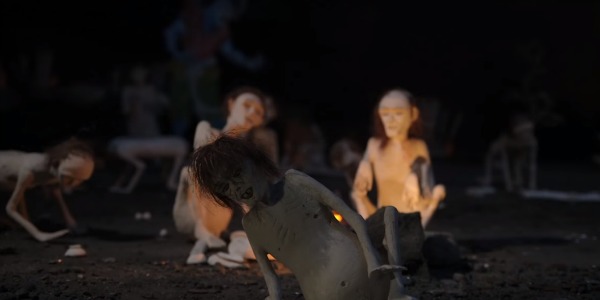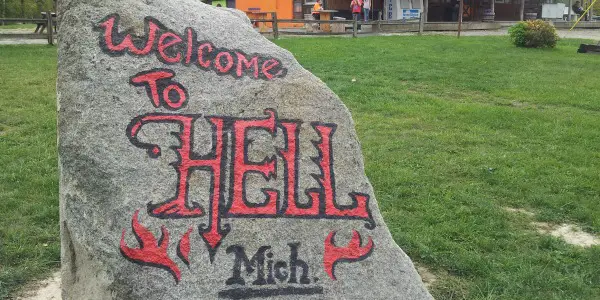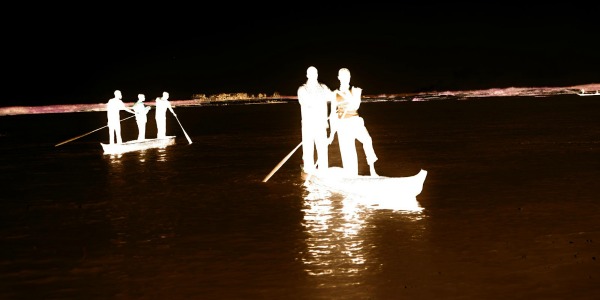SEARCHING FOR HELL: An Atmospheric Anthology of the Bizarre and Macabre

PhD Student in Culture, Film and Media at the University…
Searching For Hell is an international exploration of infernal places around the world, with a loose but entertaining concept of what hell is. In five segments, the audience visits the site of the deepest recorded excavation into the earth in Serbia, the tourist town of Hell, Michigan, a house designed to reconstruct the Buddhist conception of hell according to tenth-century writer Ojoyoshu, the toxic sulphur mines of Indonesia, and the chaotic capital of the Democratic Republic of the Congo.
Each vignette has its own style, varying from the carnivalesque to the dialectic to the observational, and the decision to release the documentary online through the Virtual Reality Cinema (VRC) app Cineveo can only add to its dreamlike, haunting quality.
The Five Circles of Hell
Unlike Dante, the filmmakers have identified five places that they interpret as either resembling or concerning the nature of cultural representations of hell. In Chapter 1, Pawel Nazaruk and Tomasz Adamski investigate the scientific endeavours of the late Soviet Union and the religious backlash they received. In Chapter 2, Darek Barecki observes the commercial and spiritual connection between the inhabitants of Hell, Michigan and Christian superstition.
Chapter 3 visits the informative reconstruction of hell established by a dedicated Buddhist and his family, which, though published centuries before Dante and on the other side of the world, shares a number of similarities with the Italian medieval poet as well as the Dutch painter Hieronymous Bosch, with a number of graphic images akin to those in his works. However, these similarities are coincidental and are neither drawn upon by the filmmakers nor the subjects themselves.

Chapters 4 and 5 are more abstract interpretations, with the former discussing the plight of ill-treated Indonesian sulphur miners as they struggle against volcanic conditions and unwanted tourist attention to complete their work, while the latter examines the disastrous mix of ancient superstition, political upheaval, poverty, and child abuse on the lives of everyday people in the Congo.
Interestingly, there are few references to popular culture’s depictions of hell in these films – with the exception of the souvenirs on display in the Hell, Michigan gift shops. Chapter 5 attempts a ham-fisted link between the early 20th century Congo described in Joseph Conrad‘s novel Heart of Darkness, but otherwise these very singular places are given their own platform and are displayed for their own sake.
Hell on Earth
The film is strongest in the first four circles. Nazaruk and Adamski have a distanced approach that allows for a voyeuristic quality, ensuring that the silence of the abandoned excavation site will evoke an eerie atmosphere of relentless calm. Though far less severe, the rubble and detritus give the scene the hint of an apocalyptic wasteland, while the superstition surrounding it and the glorification of its scientific intent suggests perhaps some evil was unearthed when the Soviets dug their hole to hell, which is now the stuff of legend.

Fortunately, though told in a more cold and sombre manner, Nazaruk and Adamski take the theological and supernatural elements of their location about as seriously as Barecki takes Hell, Michigan, which gives both segments more impact and a sense of fun. Barecki‘s survey of the visitors, attractions and residents of the small American town may be more slap-dash, but it amply captures the carefree style of its subjects. Its tone is perhaps, however, a little too contrasting to that of Nazaruk and Adamski‘s, and it may have served better as an interval sequence in the film to break the tension of the more unsettling locations.
Nevertheless, Chapter 3 is perfectly placed to get the tone and themes of the feature back on track without jarring too much in the transition from Hell, Michigan. Indeed, like the American tourist town, there are reproductions and iconographical items depicting cultural phenomena associated with hell, just of a very different kind. Unlike the American tourists, visitors to the ‘House of the Demon’ are encouraged to view the site as more of an instructional, perhaps even spiritual experience – though its creator is keen to assure visitors that he is not trying to impose his views on them or make them take a pilgrimage. Yuki Nakamura‘s assured and subtle direction frames the images and displays of the museum in a manner befitting its purpose while also creating a mystical and engaging tone for the audience.
Chapters 3 and 4 are unquestionably the highlights of the film, with Nakamura and Gloria Kurnik directing their segments in a manner akin to the documentaries of Werner Herzog, with the Kurnik‘s exploration of the Indonesia sulphur mines reminiscent of his Cave of Forgotten Dreams or Encounters at the End of the World. Kurnik manages to capture the bizarre and absorbing beauty of the mines, caves and acid lakes, which actually comprise a very ugly and unhealthy workplace.
While taking the audience on this journey, she is able to illustrate the plight and exploitation of the miners as well as their strength and stoicism. These chapters are where the VRC app comes into its own, creating an even more intimate experience for the viewer and giving them an insight into the daily lives of the workers and the location itself.
The Dark and the Light
Unfortunately, like Dante’s Inferno, the worst of Searching For Hell is saved for last. The one low point in this otherwise charming and fascinating film is James Kenney‘s pedestrian treatment of an extraordinary subject. The gimmicky use of Conrad‘s text, fades, a red wash, and an ominous voiceover makes the segment seem trite and more like a YouTube video than a contribution to a feature film.
The more interesting details – such as belief in witchcraft, shanty town abuse, Western exploitation, and the impact of AIDS and HIV – are skipped over for a poorly executed literary comparison that seems pretentious, represents the entire country solely as a seat of vice, and fails to give a voice to the people of the Congo themselves. Though well-intentioned, this only helps to patronise the Congo and its people, sadly dampening an otherwise arresting film with an interesting structure and intriguing subject matter.

Despite this, the decision to edit the film so that it creates a dramatic and logical through line from the least severe to most severe locations pays off. The opening appropriately concerns the man-made mouth to hell in a limbo-esque hinterland of broken dreams that could have been a hugely significant scientific and commercial site. Next, we move into the spiritual and reflective realms with increasingly graphic images and a tacky souvenir stall adorning the entrance. After this, things start to get toxic as we are taken into a dangerous site of labour and toil before we finally emerge in a chaotic realm at the climax of our journey.
Though the use of VRC is constructive, and more than just a showy publicity stunt, it is not essential to a positive engagement with this film. Indeed, the biggest success of Searching For Hell is its confident and skillful use of traditional documentary filmmaking techniques, strong editing and a healthy mixture of immersive and observational cinematography. Even without the added intimacy of the VRC app, this film is a testament to the power of not only its individual content, but also that of documentary film.
Conclusion
Despite a loose thematic framework and a final installment that does not live up to its predecessors, this is a solid and intriguing film that embraces the bizarre and macabre. It skilfully conveys the atmosphere and environment of a series of demonic locations, bringing them effectively to life through the use of new virtual reality technology and good, old-fashioned effective filmmaking. Though its attempts to personify its populaces are less than universally successful, the film is an unusual delight, with a gripping tone and a collection of odd, powerful and enthralling stories.
What are your thoughts on this film? Is the prospect of VRC your idea of heaven or hell? What was your response to the film and the places and people it depicts? Please comment and let me know.
Searching For Hell is available to rent and buy on Reelhouse and can be viewed on Mindprobe/Cineveo using their app.
Does content like this matter to you?
Become a Member and support film journalism. Unlock access to all of Film Inquiry`s great articles. Join a community of like-minded readers who are passionate about cinema - get access to our private members Network, give back to independent filmmakers, and more.
PhD Student in Culture, Film and Media at the University of Nottingham Blogger at [email protected]













